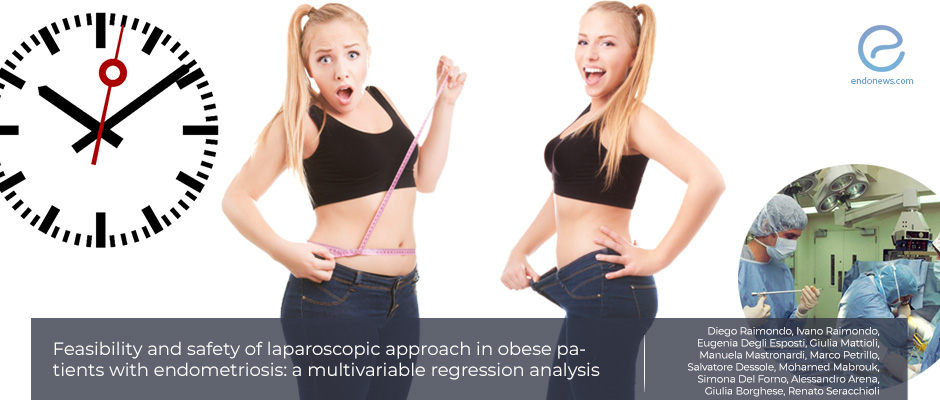The impact of obesity on safety and feasibility of laparoscopic endometriosis surgery
Jul 21, 2020
The only negative impact of obesity on laparoscopic endometriosis surgery is on the operative time.
Key Points
Highlights:
- Although body mass index and development of endometriosis has a significant inverse relationship, obesity prevalence is not rare in patients with endometriosis.
Importance:
- Obese women with endometriosis should be informed about the safety and feasibility of laparoscopic route in endometriosis surgery.
What’s done here?
- Retrospective analysis of prospectively collected data of women received laparoscopic removal of macroscopic endometriotic lesions between 2012-2018.
- The study population was divided into two groups based on the preoperative body mass index of the patients: group 1 (obese): ≥30 kg/m2 and group 2 (non-obese): <30 kg/m2.
- The demographical, clinical, and surgical characteristics, operative time, laparotomy conversion, complications, and hospital stay were compared.
- All surgical procedures were performed by an experienced endometriosis team and the diagnosis was histopathologically confirmed.
Key results:
- A total of 1230 patients were eligible, 91 women (7.4%) were in group 1 and 1139 (92.6%) were in group 2.
- Obese patients were older and had higher rates of advanced rASRM stage.
- Adhesiolysis and adnexal surgery were more frequently performed in the obese group, but urological-bowel procedures were less frequently required.
- There was no significant difference in terms of conversion to laparotomy, complication rates, hospital stay, and perioperative outcomes.
- Operative time was significantly longer in the obese group following the adjustment of confounding factors.
Strengths and Limitations
- The retrospective design and settings of the study by involving patients from a single and referral center could be accepted as a limitation.
- However, this study is the first to investigate the impact of body mass index on the safety and feasibility of laparoscopic endometriosis surgery.
Lay Summary
The quality of life in the women affected by endometriosis depends on the symptoms and signs of endometriosis such as dysmenorrhea, dyspareunia, chronic pelvic pain, and infertility. The most common locations of endometriosis are ovary, ovarian fossa, uterosacral ligament, and posterior cul-de-sac.
Although some endometriosis-associated symptoms may be managed using medical treatments, surgical management remains the golden standard of diagnosis and the treatment algorithm.
The laparoscopic surgical route is accepted as the best approach by technological developments and improved surgical skills. Obesity generally is a major concern for laparoscopic procedures. Even though endometriosis develops in non-obese women more frequently, some of the patients with endometriosis were noticed to be obese.
Raimondo et al., a group of surgeons from Italy and the United Kingdom, published a recent study entitled “Feasibility and safety of laparoscopic approach in obese patients with endometriosis: a multivariable regression analysis” in the journal named "Archives of Gynecology and Obstetrics".
The authors aimed to investigate the impact of body mass index on the safety and feasibility of laparoscopic surgery in patients with endometriosis. The demographical, clinical, and surgical characteristics of the patients were compared between groups that were divided based on the body mass index. Group 1 included 91 obese patients (7.4%) (≥30 kg/m2) whereas Group 2 included 1139 non-obese patients (92.6%) (<30 kg/m2). Laparotomic conversion, complication rates, the median length of hospital stay, and perioperative outcomes did not show any significant difference between the two groups.
However, obese women were found to have longer operative time when compared to non-obese women, after the adjustment of confounding factors.
“Obesity seems to influence the only operative time of laparoscopic approach with no significant increase of complication and laparotomy conversion rate.” the authors added.
Research Source: https://pubmed.ncbi.nlm.nih.gov/32506173/
endometriosis laparoscopy minimal access surgery obesity safety feasibility endometriosis stage

